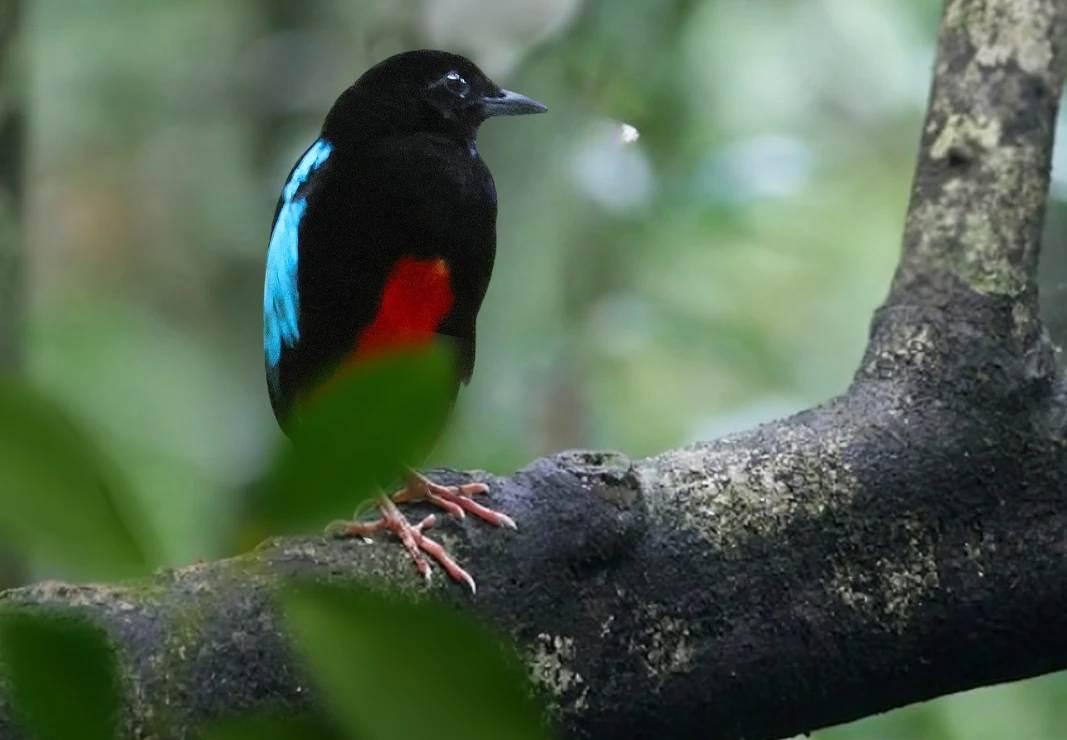Which are the best locations in Kerala to see Birds And Wildlife?
Home › Which are the best locations in Kerala to see Birds And Wildlife?
If you are planning to explore Kerala for its birds and wildlife, it helps to know where to go and what to expect. Kerala is one of the greenest states in southern India, but its thick forest cover does not always make wildlife easy to spot. Much of the forest is evergreen or rainforest, with heavy undergrowth that often blocks the view.
The state has 12 national parks and nine wildlife sanctuaries, but not all are suitable for birdwatchers or photographers looking for clear sightings. Large mammals like tigers, leopards, and wild dogs are rarely seen because of the dense terrain. Still, Kerala offers rich biodiversity for those willing to walk slowly, stay quiet, and tune in to the rhythm of the forest.
Kerala’s forests and protected areas are home to a wide range of mammals, including several rare primates found only in the Western Ghats. Commonly seen species include Asian Elephants, Indian Gaur, Sambar, Barking Deer, Spotted Deer, and Wild Dogs. Sloth Bears and Leopards turn up from time to time, but Tigers, though present, are rarely spotted.
Primates are often a highlight in the hill forests. Travellers may encounter Lion-tailed Macaques, Nilgiri Langurs, Bonnet Macaques, and the elusive Slender Loris at night. Endemic species such as the Nilgiri Tahr and Nilgiri Marten are harder to find but well worth the effort for those with a sharp eye and a bit of patience.
Birds of Kerala
KKerala is recognised as an Important Bird Area and offers strong opportunities for serious birdwatchers. Around 500 species have been recorded across the state, including a good number of endemics, residents, and winter visitors. At least sixteen birds endemic to the Western Ghats are seen regularly in Kerala’s forests and along forest edges. Notable species include White-bellied Treepie, Malabar Parakeet, Malabar Woodshrike, and Rufous Babbler. In the understorey and mid-canopy, birds such as Wynaad Laughingthrush, White-bellied Blue Flycatcher, and Black-and-orange Flycatcher often turn up. In the higher hills, one can look for Nilgiri Blue Robin, Nilgiri Flycatcher, Nilgiri Pipit, and Broad-tailed Grassbird. Malabar Grey Hornbill, Grey-headed Bulbul, and the shy White-bellied Shortwing are also worth watching for, especially if you are visiting the region with endemics in mind.
Butterflies of Kerala
Kerala’s forests and rural landscapes also support a wide diversity of butterfly species, making the state an attractive destination for lepidopterists and nature travellers alike. Recent studies suggest that approximately 325 butterfly species occur here, including several that are endemic to the region.
Notable endemics include the Malabar Banded Peacock, Malabar Raven, Malabar Rose, and the Travancore Evening Brown. These species are typically found in forested habitats, particularly in the mid- to lower elevations of the Western Ghats. Observing them often requires patience and early morning walks along forest edges, plantations, and riverbanks—settings where nectar sources and host plants are abundant.
Here, I present Kerala’s top five birding and wildlife tour destinations for you.
1. Athirappilly
Elevation: 80 M (260 Ft)
Athirappilly is a reserve forest area located within easy reach of Kerala’s Cochin International Airport, making it one of the most accessible entry points into the lower elevation forests of the Western Ghats. Although widely known for the 80-foot Athirappilly Waterfall, the forest around it offers more than just a scenic backdrop. This area falls within a recognised biodiversity hotspot and supports a range of endemic and endangered species. The forest is home to tribal communities who carry deep ecological knowledge, often referred to as bush wisdom, passed down over generations. Their sustainable way of life has drawn the attention of conservation groups, and the area is now recognised as a heritage landscape by UNESCO, adding another layer of protection to its ecosystem. Wildlife sightings may include Asiatic Elephants, Indian Gaur, and the Lion-tailed Macaque. Birdwatchers visit in search of canopy species such as the Great Indian Hornbill and Malabar Trogon. The region is also known for its butterflies and herpetofauna, particularly in the damp forest edges and along stream beds.
2. Thattekkad Bird Sanctuary
Elevation: 43 M (141 ft)
Thattekkad Bird Sanctuary, formally known as Dr Salim Ali Bird Sanctuary, is considered one of the most significant birding sites in southern India. Located at the foothills of the Western Ghats and within easy reach of Cochin, it gained international recognition after Dr Salim Ali described it as the richest bird habitat in Peninsular India. For those serious about birding, it is worth going beyond the marked sanctuary trails. The official tourist zone is limited, and the best birding often takes place in nearby areas such as Ourulanthanni, Charupara, and Cheekkodu. These forests together support at least twelve Western Ghats endemics, and over 290 species have been recorded across the Thattekkad landscape. The site is also one of the top locations in South India for night birding. Regularly seen species include Sri Lanka Frogmouth, Oriental Scops Owl, and Jerdon’s Nightjar. Slender Loris and Palm Civet may also appear after dark. If you are keen on night birding, make sure your guide knows the local trails well and follows safe nocturnal trekking practices.
3. Periyar Tiger Reserve
Elevation: 1341 M (4399 ft)
Periyar, located in the southern part of the Western Ghats, is one of Kerala’s best-known tiger reserves. While it holds healthy populations of large mammals, its dense, moist deciduous and evergreen forests make wildlife sightings a matter of patience and luck. The core zone centres around Periyar Lake, where most visitors opt for the government-run boat safaris.
These boat rides offer a chance to see Indian Gaur, Asian Elephants, Sambar, and Spotted Deer along the lake’s edge. However, the group nature of these rides and limited mobility make them less suited for wildlife photographers seeking quiet, close-range encounters.
A more rewarding option for birders and photographers is the Nature Walk—a guided trek organised by the forest department and led by trained forest watchers. These walks cover quieter trails inside the buffer and transition zones. Encounters with Western Ghats forest birds, Bonnet Macaques, Nilgiri Langurs, and even Indian Gaur are common. Though tigers and leopards inhabit the reserve, sightings are extremely rare and should not be expected.
Advance booking is recommended for the Nature Walk, and it can be arranged directly through the Kerala Forest Department’s eco-tourism portal.
4. Munnar Hills
Elevation: 1532 M (5026 ft)
Munnar is widely known as Kerala’s most popular hill station, but beyond its tea estates and scenic viewpoints, it holds strong ecological importance. The region supports some of the Western Ghats’ rarest endemic species, including the Nilgiri Tahr and the hard-to-spot Nilgiri Marten. Two key protected areas near Munnar offer different habitats. Eravikulam National Park, with its high-altitude shola and grassland mix, is the main refuge for Nilgiri Tahr.
The park is closed from February to April each year to protect the species during its breeding season, so visits should be timed accordingly. Further east, Chinnar Wildlife Sanctuary has drier scrub and deciduous forest where one may find Indian Star Tortoise and the near-threatened Yellow-throated Bulbul. This sanctuary also supports a wide range of reptiles and butterflies, drawing increasing attention from herpetologists and butterfly watchers. Munnar’s clear skies and elevation have made it a popular spot for stargazing, especially during the cooler, dry months from November to February.
5. Wayanad
Elevation: 2240 M (7349 Ft)
Wayanad, in the northernmost part of Kerala, forms an ecologically and culturally rich corridor within the Western Ghats. Its forests connect with protected areas in Tamil Nadu and Karnataka, forming a broader landscape that includes Bandipur, Nagarhole, and Silent Valley. This wider region supports wide-ranging species such as elephants and large carnivores. Wayanad’s terrain is heavily forested and inhabited by tribal communities whose lives remain closely tied to the land. The region’s cultural depth is marked by the Edakkal Caves, where ancient rock engravings, some dating back to 8000 BC, give insight into prehistoric human presence. Archaeologists have noted similarities between these markings and those found in the Indus Valley civilisation. Wayanad Wildlife Sanctuary, also called Muthanga, serves as the main entry point for nature-focused travellers. Although the thick forest can make sightings of leopards and smaller mammals unpredictable, Asian Elephants, Indian Gaur, Sambar, and Spotted Deer are commonly seen. Birders often visit in search of the Wayanad Laughingthrush, a Western Ghats endemic, and sometimes catch a glimpse of the Lion-tailed Macaque in quieter stretches of forest.
This article was written by a tour leader at Endemic Explorer.
Endemic Explorer is a theme-based travel company specialising in professionally guided birding and wildlife tours across India and beyond. Our journeys focus on endemic species, biodiversity hotspots, and meaningful engagement with nature. Each itinerary is crafted with ecological sensitivity and field expertise to offer in-depth, location-specific experiences for serious travellers.
To explore our upcoming departures or to learn more about our work, visit www.endemicexplorer.com or email us at info@endemicexplorer.com.
Latest Post

Papua New Guinea Bird Photography Tour Report – 2024

Chasing the Super Pitta: A Journey to Manus Island

